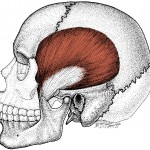 There are two sets of large muscles that can cause pain in your jaw and the area around your jaw joint: the massater muscles and the temporalis muscles. Check out the Category for Jaw Pain on this website for more articles on the massater and other muscles that can be involved.
There are two sets of large muscles that can cause pain in your jaw and the area around your jaw joint: the massater muscles and the temporalis muscles. Check out the Category for Jaw Pain on this website for more articles on the massater and other muscles that can be involved.
You can feel the muscle that crosses your jaw joint if you place your fingers over the joint and pretend you are chewing. That’s the massater. You have two–one on each side.
You can also feel the temple muscles by placing your fingers on the sides of your head in line with your eyebrows and pretending to chew. Again, this muscle is on each side of your head. It the temporalis muscle.
There is a depression in your skull on each side and the temporalis muscle is packed in there. It’s actually a pretty good sized muscle.
The red area in the picture is the muscle and the white area that attaches to the lower jaw bone is the tendon.
Beside causing head and jaw pain, these muscles can also cause pain in your teeth! It’s not your teeth, though. It’s trigger points in the muscle that fire into your teeth and cause it to feel like tooth pain.
What can you do to make the temporalis muscle relax so it will bother you less?
1. Pull your hair. If you do this correctly it is called ‘Cranial Fascial Release.’ Here’s how:
Glide your fingers through your hair at the scalp over your temple muscles. Close or clench your fingers with hair laced between them. As you do this, you will start pulling your hair at the roots or scalp. You will feel the pull or stretch on your head.
This is different from holding your hair away from your head and pulling. One woman told me, “Oh yes, I know about hair pulling–I had sisters!” Ouch!
This type of pulling will help lift the skin and muscle and fascia from the bone. It will help relax the muscle.
At first it will feel quite tender but if you can hold it for several seconds you will feel less tenderness. That’s because the muscle is relaxing.
After a few sessions, you can slightly twist your hand after you clench your fingers around your hair at the scalp. Twist your clenched hand to the right and hold until you feel the muscle start to be less tender. And then twist in the opposite direction. It’s usually too tender to lift and twist the first time or two.
As you can see in the picture, this is a large, wide muscle. Work the whole muscle by moving your hand to adjacent areas and starting the pulling again in each area.
You don’t have to do the whole muscle or both temple muscles at once. You can do a little and take a break if your hand gets tired. Just come back to it later when you are ready.
Some therapists try pressing into the temporalis muscles. This doesn’t seem to work as well as pulling them and I, personally, find it to be pretty annoying.
2. Apply either warm compresses or cold packs to these muscles. If heat is the wrong choice, your muscles will feel a bit worse rather than better and more relaxed. If that happens, switch to cold packs. You can also use contrast therapy by applying heat, cold, heat, cold.
The good thing about applying heat or cold therapy is that you are also treating nearby muscles at the same time. Check out the Ice & Heat Category here.
3. There’s a good chance that the muscles at the base of your head are also involved. Heat might be a fine treatment there at the top of your neck because heat is usually the treatment of choice for muscles.
But if the nerves are aggravated at the base of your skull then cold therapy is the way to go. Cold is the best therapy for nerves.
4. Chewing food and gum may aggravate your symptoms OR chewing may help your muscles to relax. It depends on the cause of your jaw pain and how tight the muscles are.
Pretending to chew with your lips closed and teeth apart may help your chewing muscles to relax.
5. Posture can cause jaw pain. Check your posture. If your head is forward (in front of your body) rather than over your body it strains the muscles around the jaw.
If you have upper back and neck pain or knots in your back, there is a great chance that your posture needs improvement.
Gravity is always trying to pull us forward and down. We can counteract that by keeping a strong back side from knees to head. There are articles at http://SimpleStrengthening.com to help you strengthen your backside.
If you take action you can help your temporalis muscles relax and help your jaw to feel better naturally.


Hi Kathryn,
I find your articles very fascinating. I also have been having a tooth ache on the top left side of my mouth and also sometimes on the lower left side of my mouth. My temples hurt especially the one on the left side. My jaw also aches along with the back side of my neck. this has been going on for over three months. I have been to the dentist and they have taken x-rays and a 3-D image of my teeth and cannot find where the pain is coming from. They told me to go to my ENT as I also have an earaches form all of this pain. The ENT told me that he does not see anything and that either it still may be a tooth or TMJ or maybe a sinus problem. My ENT recommends getting a cat scan scheduled so they can narrow things down to what it may me. My problem is my ins. does not pay for these types of scans until after my $5000 deductible is met. So I think maybe I should try some of your exercises to try and get relief. It is just so frustrating to go through all this pain for so long and just get shuffled from one Dr. to another. On another note my husband is just recovering from head and neck cancer and just finished up his last radiation treatments and maybe all of this is coming from extreme stress from being his caregiver. But the continued pain tells me no as he is now getting better.
Would appreciate your feedback on this.
Thank you,
Anji
Dear Anji,
The massater muscles are your ‘hinge’ muscles–they allow you to move your lower jaw. There are also large chewing muscles in your temples. If you place your palms on your temples and make a chewing movement, you will feel the temporal muscles moving. When these or other muscles around your neck, head and mouth are tight or develop ‘trigger points’ they can cause a lot of pain and symptoms just like yours.
We will assume that the dentist is correct and the diagnosis was good.
Perhaps when your husband was ill you had to sit in uncomfortable chairs while waiting for his treatments or in the hospital. Perhaps you have to drive far distances and your car seat doesn’t fit you well. Maybe you were clenching your teeth. Any poor postures can cause the jaw muscles to tighten. And sometimes muscles just don’t remember how to relax; they need a bit of help.
There are skilled massage therapists who know how to specifically release or relax these muscles. It may take a few sessions because there is only so much time in a session and when muscles are tight, it can take a bit of finessing to help them relax. I just saw a client for the second time and as we work, she learns what she can continue to do at home between monthly sessions.
Fortunately, you can reach the muscles in your face and head yourself. In a nutshell, you will want to ‘pinch’ the hinge muscles between your thumb (goes inside your mouth on the opposite cheek) and your fingers (placed on the outside of your cheek.) You may have a lot of tenderness where you start but you want to get waaaay back toward the hinge. You will be able to feel the tight muscle. The idea is to compress it, press into it, get the blood flowing again and help it relax. You can do this around your whole mouth area as long as you don’t have long finger nails. You want to apply enough pressure that you feel some discomfort (about a 6 or 7 on a scale of 10.)
The temporal muscles can be warmed and relaxed by holding your hair close to your scalp and clenching your fingers around the hair to cause a pull. You can also warm them with warm packs as long as that doesn’t make it feel worse. You may find warm packs to be very helpful.
The jaw muscles will also cause ear pain and teeth pain.
If you’d like, just to be on the safe side, you might want to have a second dentist or oral surgeon look at the x-rays. Sometimes a second opinion is very helpful. The second person may see something the first didn’t. (I’m thinking infection.) But if you start squeezing and warming the muscles and start to feel better (even a bit) and still feel better the next day, that’s a big clue that muscles are the problem.
I hope this helps you get rid of the pain in your jaw. I’d love to know of your progress.
Kathryn
The Pain Relief Coach